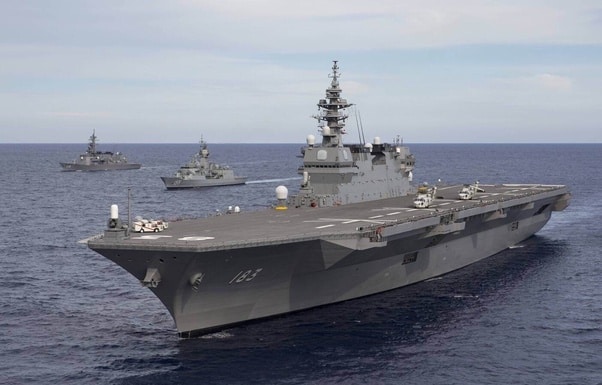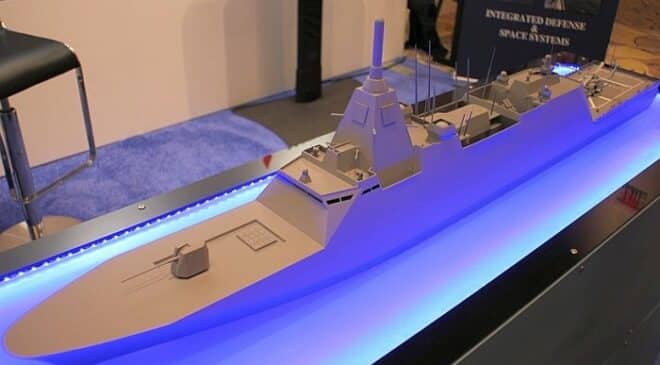The destroyer “Haguro”, the second unit of the Maya class, was launched on July 17 by the JMU (Japan Maritime United) shipyards, near the city of Yokohama. Weighing more than 10.000 tonnes and 170 meters long, the Haguro is a Japanese version of the American Arleigh Burke Flight III heavy destroyer. The Haguro, like its sister ship the Maya, is equipped with the AEGIS system, and 96 vertical launch silos carrying SM2ER anti-aircraft missiles, SM3 and SM6 anti-missiles, and ASROC torpedo missiles, to which are added 8 launchers for Type 17 anti-ship missiles, 2 triple torpedo launchers, 2 CIWS Phalanx and 1 127mm cannon. The building carries a variable depth sonar in addition to its hull sonar, a high-power SPY-1D radar, and uses an SH-60K helicopter. In fact, the Haguro is only inferior in firepower to the US Navy's Ticonderoga cruisers, the Chinese Type 055, and a possible Russian Kirov.
The Haguro is the 8th and last Japanese Aegis destroyer of the Kongo family built to date. This family, close to the American Arleigh Burkes, includes the Kongo class (9500 tonnes) with 4 units launched between 1994 and 1998, the Atago class (10.000 tonnes) with 2 units entering service in 2007, and the Maya class, to which it belongs. , and whose first unit was launched last year. These heavy destroyers mark a profound transformation of the naval force of the Japanese self-defense forces, which, from 1990, undertook to increase the firepower, tonnage and number of its buildings.

And today, the Japanese Navy is objectively the 3rd most powerful Navy in the world, on par with the Russian Navy, behind the American and Chinese navies, in particular thanks to its surface combatant component of 26 destroyers and frigates. , 16 corvettes and 30 mine hunters, to which are added 4 LHDs and 19 attack submarines. This fleet is supported by more than 80 P3 and P1 maritime patrol aircraft, 130 helicopters, and, soon, 40 F15Bs intended to equip the 2 Izumo class helicopter destroyers.
This modernization is not intended to mark time, especially as China continues to grow its naval and air force at a very significant rate, launching between 130.000 and 180.000 tonnes of military vessels each year. Thus, the future of the Japanese navy rests on two concomitant programs:
- the 30DX program, intended to replace the light destroyers of the Abukama and Asagiri class, will be the most prolific, with 22 frigates of 130 meters and 5500 tonnes planned to enter service from 2022. Like a French FDI, the 30DX will be equipped with 16 launch silos for long-range Type 03 anti-aircraft missiles and 8 Type 17 anti-ship missiles to which are added a short-range Sea-RAM self-protection system (24 missiles), 2 tubes torpedo launcher, and a 127 mm cannon. The vessels will be equipped with an OPY-2 AESA radar, and a bow sonar coupled with a variable depth sonar, for ASM missions, as well as an ASM SH60K helicopter.
- The 33DD program is intended to replace the destroyer escorts, and to reinforce the Asahi class destroyers. The final model has not yet been finalized, but the buildings will emphasize anti-aircraft defense and very stealthy architecture. The first unit is due to enter service in 2024.

In 2030, the Japanese naval forces will field a high-seas fleet made up of 8 heavy destroyers, 12 escort destroyers and 26 frigates, more than 3 times the French or British fleet of the same type, supported by 20 Soryu-type submarines. and advanced Soryu, submersibles of 4000 to 5000 tonnes in diving, and with performances close to that of a nuclear attack submarine, again, 3 times greater than the French submarine fleet (6 SSN Suffren class ) or British (7 Astute class SSN).
